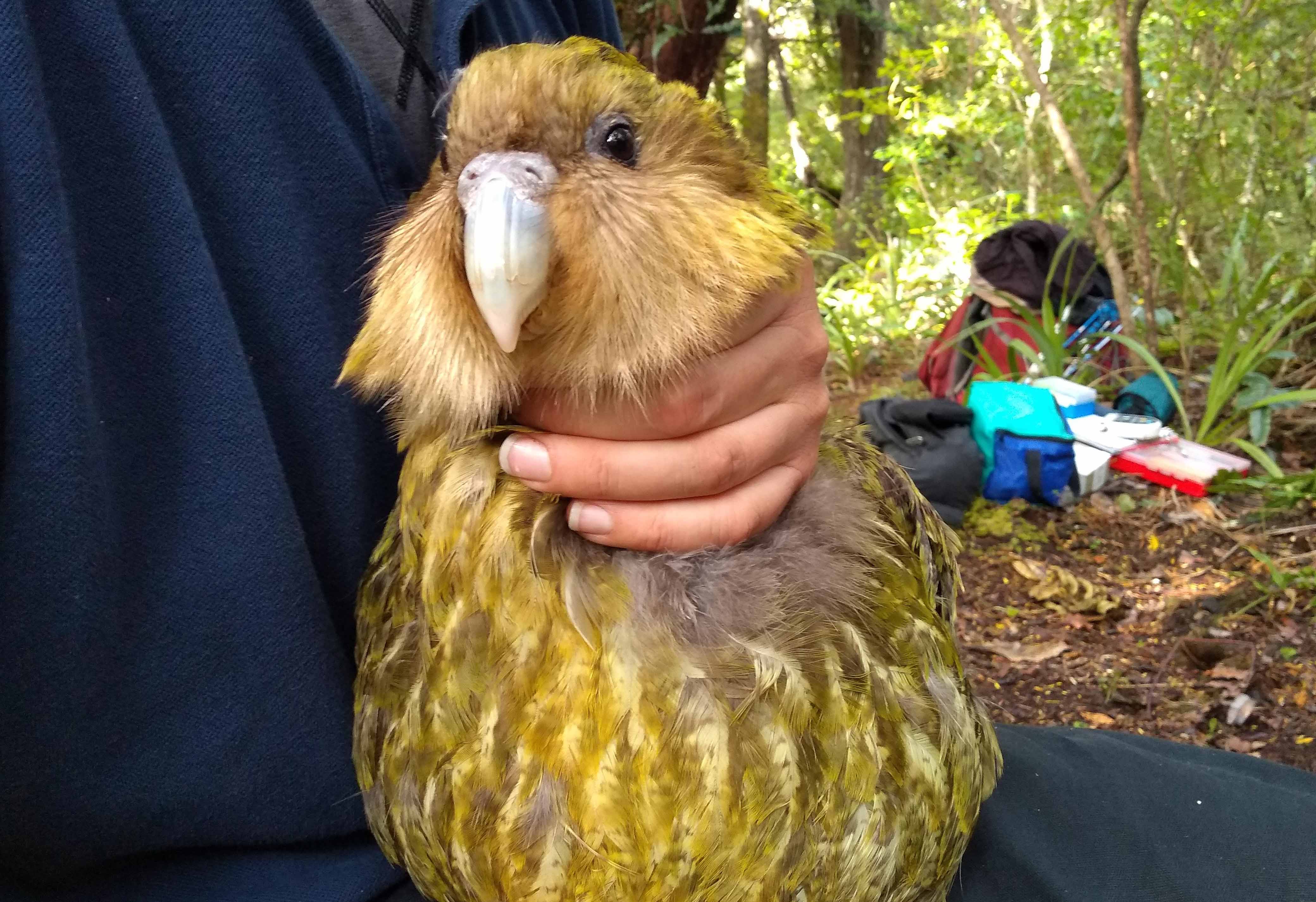
Life with the endangered kākāpō
How genomics can support the conservation of a most unusual bird – the kākāpō

By Lara Urban, EMBL-EBI PhD student
The kākāpō is an odd sight. With its green-yellow plumage and distinctly round face, this flightless parrot has been on the brink of extinction for many decades, mainly due to introduced predators and habitat loss. Fewer than 200 individuals now inhabit three predator-free islands just off the coast of New Zealand. This is the only place in the world where the kākāpō can still be found.
Most endangered species are affected by a major loss of genetic diversity. This makes them less able to adapt and less resilient to changes in their environment. In turn, they become even more vulnerable.
I travelled to New Zealand to understand how genomics research can support the recovery of this endearing bird. Specifically, I was interested in detecting links between genetic variation and fitness traits of the kākāpō. I also wanted to find out how researchers can use this information to devise a strategy to conserve the species.

Out of the lab
I first joined the pioneer of kākāpō genetics, Bruce Robertson, at Otago University in Dunedin, New Zealand, to work on the genomes of all living kākāpō. The data are available thanks to the Kākāpō125+ project, an ambitious initiative run by the Kākāpō Recovery Programme and the Māori iwi Ngāi Tahu, with funding organised by the Genetic Rescue Foundation.
We started by quantifying the genetic diversity of the current kākāpō population. In an ongoing collaboration, we are investigating associations between genetic variation and phenotypic traits using machine learning and statistical methodology.
This will allow us to explore how genetics contribute to the kākāpō’s fitness, fertility and susceptibility to disease, and how inbreeding affects these traits. Using information on genetic relatedness of the individuals and presence of highly heterogeneous regions in their genome, we can prioritise individuals in a breeding programme that aims to increase the genetic diversity of the population.
We can also use genetic data to understand the susceptibility to the cloacitis disease that plagues the kākāpō population. In addition to gaining a better understanding of the disease and possible treatments, this knowledge will inform conservation decisions within the Kākāpō Recovery Programme.
And into the field
During my time in New Zealand, I had the rare opportunity to do fieldwork on Whenua Hou, one of the kākāpō’s last island refuges. There, I was able to understand the practicalities of conservation work. I also assessed the applicability of findings from genomics research to conservation in the field. I was fortunate to be able to study the kākāpō during one of its rare breeding seasons. This meant taking part in the artificial insemination process, egg incubation and even hand rearing chicks.
One of the highlights was meeting Gulliver, a male kākāpō with rare and therefore invaluable genes. I will also never forget how it feels to spend the night alone in the untouched nature of Whenua Hou, only a few metres away from a kākāpō nest, carefully monitoring a female bird’s wellbeing and listening to the unique, deep ‘booming’ call of the male birds out in the woods.

The overarching aim of this work is to bring an entire species back from the brink of extinction and keep it alive to amaze future generations with its particular traits and behaviour, whilst emphasising the importance of nature conservation.
A look towards the future
The encouraging news is that the prospects for the kākāpō look good. The 2019 breeding season has been the most successful since the beginning of the kākāpō recovery efforts. However, the kākāpō is far from saved.
So what comes next? We will generate a comprehensive genotype–phenotype catalogue of the entire kākāpō population and use this complex dataset to assist the recovery of the kākāpō in the coming decades. I am certain that, as a forerunner in genomic conservation efforts, the Kākāpō Recovery Programme will inform future conservation projects, providing guidelines on how genomics can support conservation.
As for me, I have decided to continue my research by studying another endangered bird in New Zealand: the takahē. This species was presumed to be extinct for almost half a century, before several individuals were found alive and well in an isolated valley in the remote Murchison Mountains. The takahē has an interesting story to tell – and hopefully we can discover at least some of it using genomics.
If you would like to support the kākāpō conservation efforts, you can donate on New Zealand’s Department of Conservation website.

Lara’s expedition was made possible with the support of the Heredity Fieldwork Grant of the Genetics Society.



